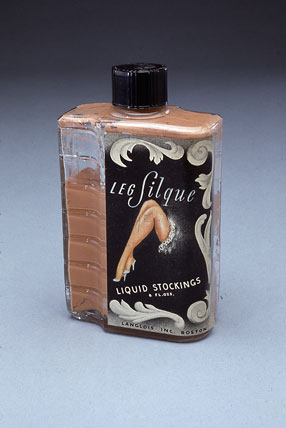As COVID-19 deaths spiked in 2020, Suzanne Firstenberg’s public art installation "In America: How could this happen…"
History Explorer Results (19)
Related Books (1)

Grade Range:
4-12
Resource Type(s):
Reference Materials, Primary Sources
Date Posted:
5/27/2009
Students will learn about the importance of salmon fishing to the Native Americans of the Pacific Northwest, and the communities that developed around the Atlantic cod, Chesapeake oyster, Columbia River salmon and whaling industries in this section of On the Water: Stories from Mari

Grade Range:
K-12
Resource Type(s):
Artifacts, Primary Sources
Date Posted:
11/10/2008
While leg makeup has been commercially available since the 1920s, it wasn't until rationing was introduced during the World War II that the product became an essential commodity for many American women. Unable to procure silk or nylon hose, many women resorted to painting their legs with products

Grade Range:
K-12
Resource Type(s):
Artifacts, Primary Sources
Date Posted:
11/6/2008
During World War I, machine guns were heavy, crew-served weapons. Their operation required several soldiers. Even so-called light machine guns could not easily be handled by single soldiers. To meet the need for an individual rapid-fire weapon, several inventors devised submachine guns. Light eno

Grade Range:
K-12
Resource Type(s):
Artifacts, Primary Sources
Date Posted:
11/5/2008
From the 1920s, psychologists have explored ways to automate teaching. In the 1950s, the psychologist B. F. Skinner of Harvard University suggested that techniques he had developed for training rats and pigeons might be adopted for teaching humans.

Grade Range:
K-12
Resource Type(s):
Artifacts, Primary Sources
Date Posted:
11/4/2008
Life on America's farms in the 1920s and 1930s meant hard work and frugal habits. Farm families were used to "making do" with what they had, wasting nothing that could be recycled or reused. With feed sacks and flour bags, farmwomen took thriftiness to new heights of creativity, transforming the

Grade Range:
K-12
Resource Type(s):
Artifacts, Primary Sources
Date Posted:
9/3/2008
In January 1917, members of the National Woman's Party (NWP) became the first people to picket the White House. Protesting the government's failure to pass a constitutional amendment enfranchising women, NWP members, led by Alice Paul, began picketing the White House. Their purple, white, and gol
Grade Range:
9-12
Resource Type(s):
Reference Materials
Date Posted:
7/7/2008
Students can learn about the 1921 U.S. Lighthouse Service tender Oak. This reference page is included in the online exhibition entitled America on the Move, which focuses on transportation in US history.

Grade Range:
8-12
Resource Type(s):
Reference Materials
Duration:
5 minutes
Date Posted:
9/3/2013
In this post, readers will discover the man and the reasoning behind what is now Black History Month, observed around the country every February. Dr. Carter G. Woodson spent my of the early decades of the 20th century promoting the study and seriousness of African American histor

Grade Range:
8-12
Resource Type(s):
Reference Materials
Date Posted:
7/10/2012
In this post, students will discover the history of electric car technology over the course of the last century. In the early 20th century, motorists had a choice of electric, steam, or gasoline cars, and it wasn’t clear that any one type would dominate the market. Electricity was beginnin










